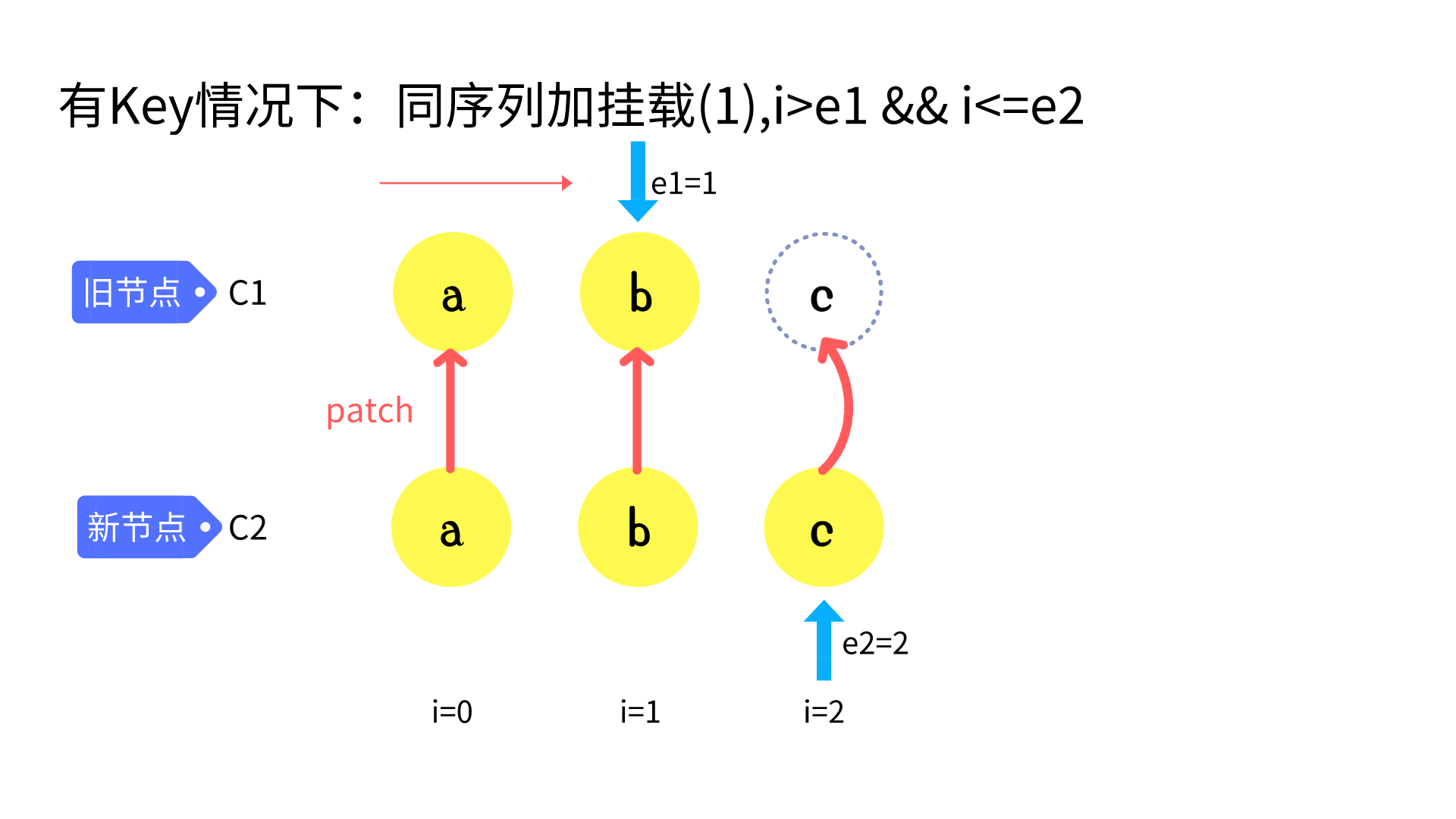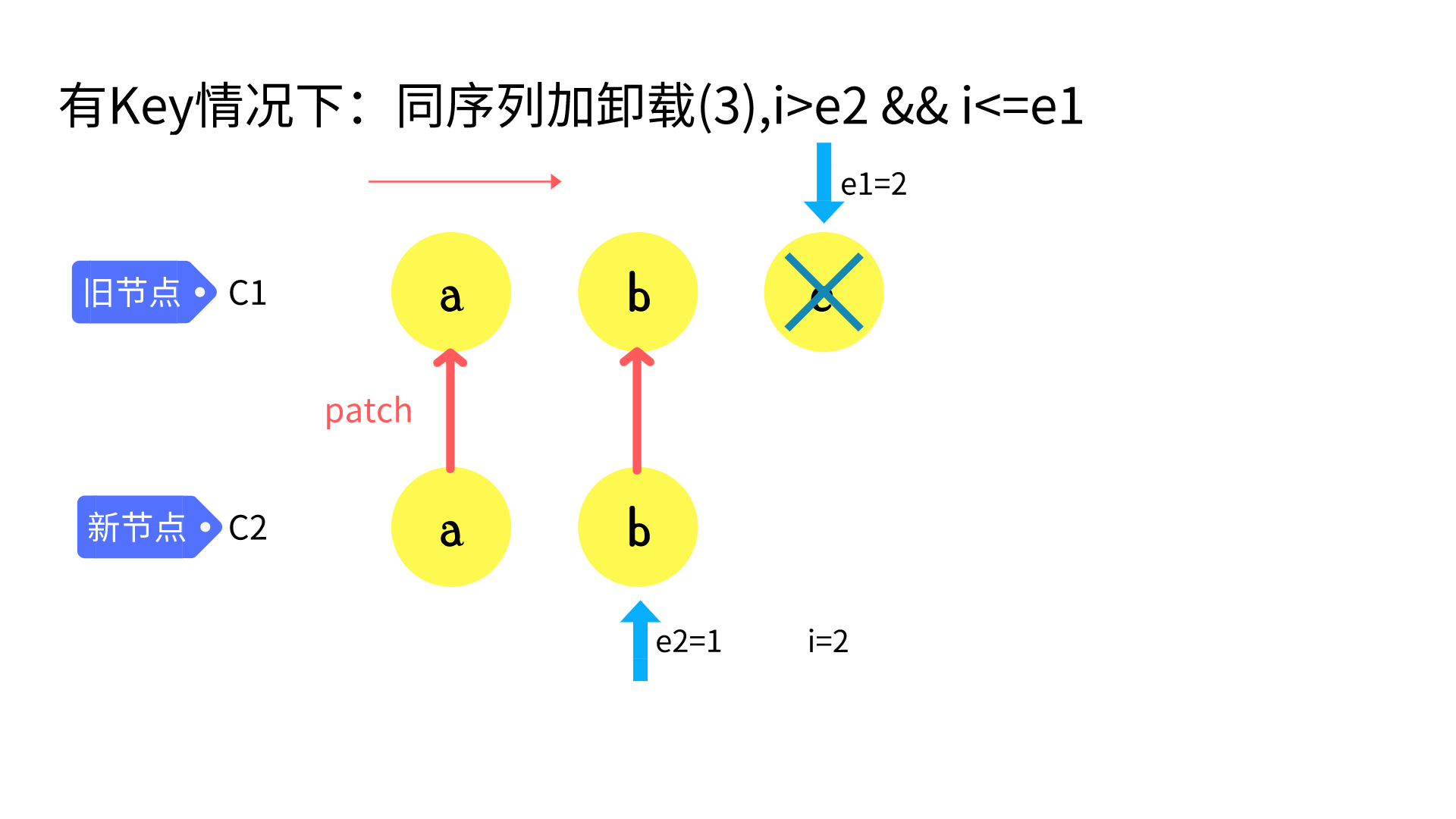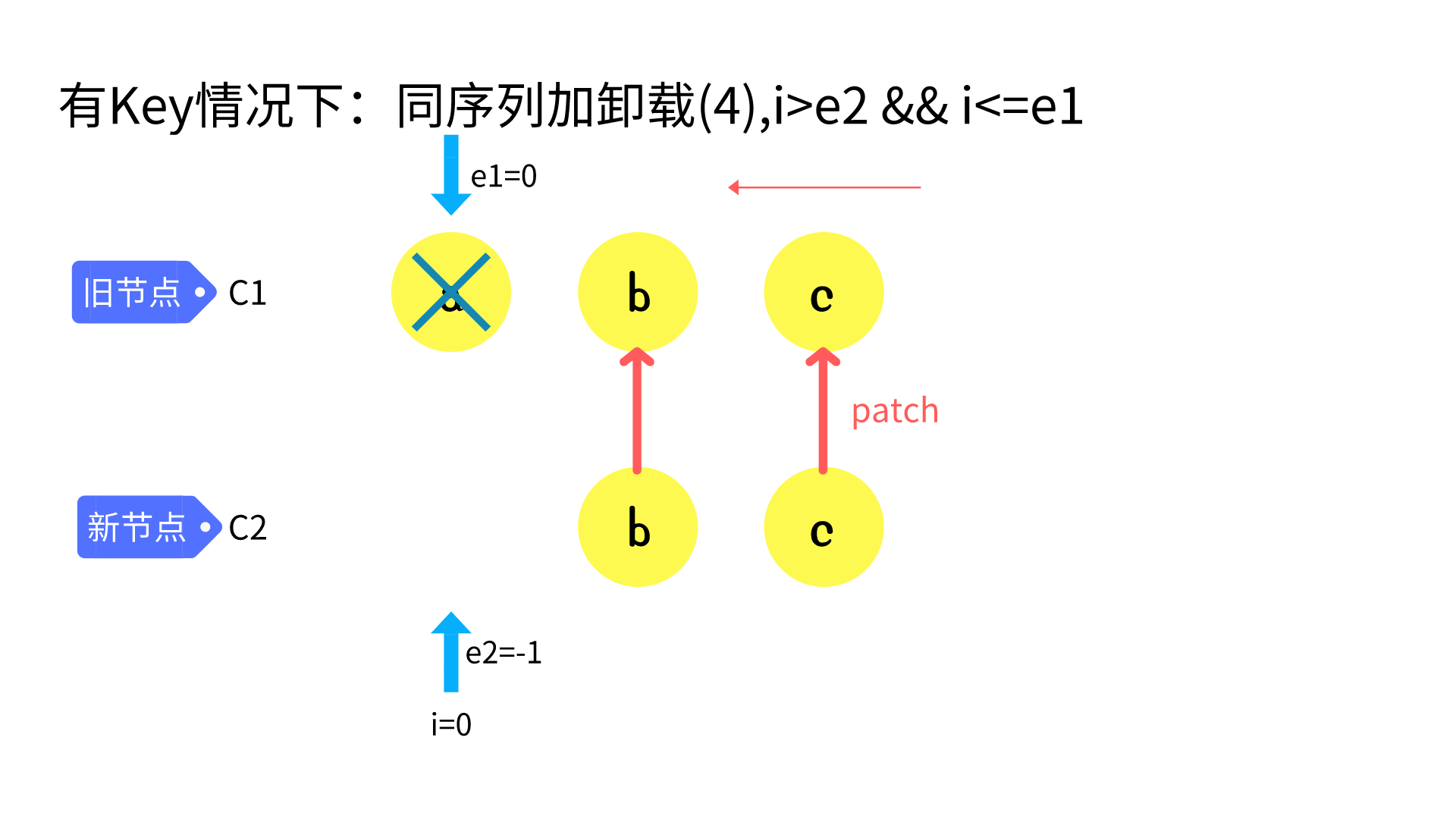从零手写Vue3 中diff算法
一.组件更新
当依赖的属性变化时,会重新执行effect函数,我们再次调用render方法生成新的虚拟DOM,进行
diff操作
instance.update = effect(function componentEffect() {
if (!instance.isMounted) {
// ...
} else {
const prevTree = instance.subTree;
const proxyToUse = instance.proxy;
const nextTree = instance.render.call(proxyToUse, proxyToUse); // 在来一次
instance.subTree = nextTree
patch(prevTree, nextTree, container);
}
})
1
2
3
4
5
6
7
8
9
10
11
2
3
4
5
6
7
8
9
10
11
二.前后元素不一致
两个不同虚拟节点不需要进行比较,直接移除老节点,将新的虚拟节点渲染成真实DOM进行挂载即可
const { createApp, h, reactive } = VueRuntimeDOM;
const App = {
setup() {
let state = reactive({ flag: true });
return {
state
}
},
render: (r) => {
return r.state.flag ? h('div', {
onClick: () => {
r.state.flag = false;
}
}, 'hello') : h('p', {}, 'world')
}
}
createApp(App).mount('#app');
1
2
3
4
5
6
7
8
9
10
11
12
13
14
15
16
17
2
3
4
5
6
7
8
9
10
11
12
13
14
15
16
17
切换显示不同的节点
const isSameVNodeType = (n1, n2) => {
return n1.type == n2.type && n1.key === n2.key
}
const unmount = (vnode)=>{
hostRemove(vnode.el); // 未考虑组件情况
}
const patch = (n1, n2, container, anchor = null) => {
const { shapeFlag, type } = n2;
if (n1 && !isSameVNodeType(n1, n2)) {
anchor = hostNextSibling(n1.el); // 获取老元素下一个元素
unmount(n1);
n1 = null;
}
}
1
2
3
4
5
6
7
8
9
10
11
12
13
14
2
3
4
5
6
7
8
9
10
11
12
13
14
三.前后元素一致
const App = {
setup() {
let state = reactive({ flag: true });
return {
state
}
},
render: (r) => {
return r.state.flag ? h('div', {
style: { color: 'red' },
onClick: () => {
r.state.flag = false;
}
}, 'hello') : h('div', { style: { color: 'blue' } }, 'world')
}
}
createApp(App).mount('#app');
1
2
3
4
5
6
7
8
9
10
11
12
13
14
15
16
17
2
3
4
5
6
7
8
9
10
11
12
13
14
15
16
17
前后虚拟节点一样,则复用DOM元素,并且更新属性和子节点
const patchElement = (n1, n2, anchor) => {
// 两个元素相同 1.比较属性 2.比较儿子
let el = (n2.el = n1.el);
const oldProps = n1.props || {};
const newProps = n2.props || {};
patchProps(oldProps, newProps, el)
patchChildren(n1, n2, el, anchor);
}
1
2
3
4
5
6
7
8
2
3
4
5
6
7
8
1.属性更新
const patchProps = (oldProps, newProps, el) => {
if (oldProps !== newProps) {
// 新的属性 需要覆盖掉老的
for (let key in newProps) {
const prev = oldProps[key];
const next = newProps[key];
if (prev !== next) {
hostPatchProp(el, key, prev, next);
}
}
// 老的有的属性 新的没有 将老的删除掉
for (const key in oldProps) {
if (!(key in newProps)) {
hostPatchProp(el, key, oldProps[key], null);
}
}
}
}
1
2
3
4
5
6
7
8
9
10
11
12
13
14
15
16
17
18
2
3
4
5
6
7
8
9
10
11
12
13
14
15
16
17
18
2.比较儿子节点
针对子节点类型做基本
diff操作,最复杂的情况莫过于双方都有儿子的情况
const unmountChildren = (children) => {
for (let i = 0; i < children.length; i++) {
unmount(children[i])
}
}
const patchChildren = (n1, n2, container, anchor = null) => {
const c1 = n1.children; // 获取所有老的节点
const c2 = n2.children; // 获取新的所有的节
const prevShapeFlag = n1.shapeFlag; // 上一次元素的类型
const shapeFlag = n2.shapeFlag; // 这一次的元素类型
if (shapeFlag & ShapeFlags.TEXT_CHILDREN) { // 目前是文本元素
if (prevShapeFlag & ShapeFlags.ARRAY_CHILDREN) { // 老的是数组
unmountChildren(c1); // 可能有组件 调用组件的卸载方法
}
if (c2 !== c1) {
hostSetElementText(container, c2)
}
} else {
if (prevShapeFlag & ShapeFlags.ARRAY_CHILDREN) { // 新老都是数组
if (shapeFlag & ShapeFlags.ARRAY_CHILDREN) {
patchKeydChildren(c1, c2, container, anchor); // core
} else {
// 没有新孩子
unmountChildren(c1);
}
} else {
if (prevShapeFlag & ShapeFlags.TEXT_CHILDREN) {
// 移除老的文本
hostSetElementText(container, '');
}
if (shapeFlag & ShapeFlags.ARRAY_CHILDREN) {
// 去把新的元素进行挂在 生成新的节点塞进去
mountChildren(c2[i], container, anchor);
}
}
}
}
1
2
3
4
5
6
7
8
9
10
11
12
13
14
15
16
17
18
19
20
21
22
23
24
25
26
27
28
29
30
31
32
33
34
35
36
37
38
2
3
4
5
6
7
8
9
10
11
12
13
14
15
16
17
18
19
20
21
22
23
24
25
26
27
28
29
30
31
32
33
34
35
36
37
38
四.核心Diff算法
针对双方儿子都是数组形式
const App = {
render: (r) => {
return r.state.flag ?
h('div',
[
h('li', { key: 'A' }, 'A'),
h('li', { key: 'B' }, 'B')
]
) :
h('div',
[
h('li', { key: 'A' }, 'A'),
h('li', { key: 'B' }, 'B')
]
)
}
}
createApp(App).mount('#app');
1
2
3
4
5
6
7
8
9
10
11
12
13
14
15
16
17
18
2
3
4
5
6
7
8
9
10
11
12
13
14
15
16
17
18
1.sync from start

const patchKeydChildren = (c1, c2, container, anchor) =>{
let i = 0;
const l2 = c2.length;
let e1 = c1.length - 1;
let e2 = l2 - 1;
// 1. sync from start
// (a b) c
// (a b) d e
while(i<=e1 && i<=e2){
const n1 = c1[i];
const n2 = c2[i];
if(isSameVNodeType(n1,n2)){
patch(n1,n2,container,null)
}else{
break;
}
i++;
}
}
1
2
3
4
5
6
7
8
9
10
11
12
13
14
15
16
17
18
19
2
3
4
5
6
7
8
9
10
11
12
13
14
15
16
17
18
19
2.sync from end

// 2. sync from end
// a (b c)
// d e (b c)
while (i <= e1 && i <= e2) {
const n1 = c1[e1];
const n2 = c2[e2];
if (isSameVNodeType(n1, n2)) {
patch(n1, n2, container, null);
} else {
break;
}
e1--;
e2--;
}
1
2
3
4
5
6
7
8
9
10
11
12
13
14
2
3
4
5
6
7
8
9
10
11
12
13
14
3.common sequence + mount


// 3. common sequence + mount
// (a b)
// (a b) c
// i = 2, e1 = 1, e2 = 2
// (a b)
// c (a b)
// i = 0, e1 = -1, e2 = 0
if (i > e1) { // 说明有新增
if (i <= e2) { // 表示有新增的部分
// 先根据e2 取他的下一个元素 和 数组长度进行比较
const nextPos = e2 + 1;
const anchor = nextPos < c2.length ? c2[nextPos].el : null;
while (i <= e2) {
patch(null, c2[i], container, anchor);
i++;
}
}
}
1
2
3
4
5
6
7
8
9
10
11
12
13
14
15
16
17
18
2
3
4
5
6
7
8
9
10
11
12
13
14
15
16
17
18
4.common sequence + unmount


// 4. common sequence + unmount
// (a b) c
// (a b)
// i = 2, e1 = 2, e2 = 1
// a (b c)
// (b c)
// i = 0, e1 = 0, e2 = -1
else if (i > e2) {
while (i <= e1) {
unmount(c1[i], parentComponent, parentSuspense, true)
i++
}
}
1
2
3
4
5
6
7
8
9
10
11
12
13
2
3
4
5
6
7
8
9
10
11
12
13
5.unknown sequence
1).build key:index map for newChildren

// 5. unknown sequence
// a b [c d e] f g
// a b [e c d h] f g
// i = 2, e1 = 4, e2 = 5
const s1 = i;
const s2 = i;
const keyToNewIndexMap = new Map();
for (let i = s2; i <= e2; i++) {
const nextChild = c2[i];
keyToNewIndexMap.set(nextChild.key, i);
}
1
2
3
4
5
6
7
8
9
10
11
2
3
4
5
6
7
8
9
10
11
2).loop through old children left to be patched and try to patch
const toBePatched = e2 - s2 + 1;
const newIndexToOldMapIndex = new Array(toBePatched).fill(0);
for (let i = s1; i <= e1; i++) {
const prevChild = c1[i];
let newIndex = keyToNewIndexMap.get(prevChild.key); // 获取新的索引
if (newIndex == undefined) {
unmount(prevChild); // 老的有 新的没有直接删除
} else {
newIndexToOldMapIndex[newIndex - s2] = i + 1;
patch(prevChild, c2[newIndex], container);
}
}
1
2
3
4
5
6
7
8
9
10
11
12
2
3
4
5
6
7
8
9
10
11
12
3).move and mount

for (let i = toBePatched - 1; i >= 0; i--) {
const nextIndex = s2 + i; // [ecdh] 找到h的索引
const nextChild = c2[nextIndex]; // 找到 h
let anchor = nextIndex + 1 < c2.length ? c2[nextIndex + 1].el : null; // 找到当前元素的下一个元素
if (newIndexToOldMapIndex[i] == 0) { // 这是一个新元素 直接创建插入到 当前元素的下一个即可
patch(null, nextChild, container, anchor)
} else {
// 根据参照物 将节点直接移动过去 所有节点都要移动 (但是有些节点可以不动)
hostInsert(nextChild.el, container, anchor);
}
}
1
2
3
4
5
6
7
8
9
10
11
2
3
4
5
6
7
8
9
10
11
五. 最长递增子序列
Vue3 采用最长递增子序列,求解不需要移动的元素有哪些
function getSequence(arr){
const len = arr.length;
const result = [0]; // 保存最长递增子序列的索引
let resultLastIndex;
for(let i = 0; i < len; i++){
const arrI = arr[i]; // 获取数组中的每一项,但是0 没有意义我们需要忽略掉
if(arrI !== 0){
resultLastIndex = result[result.length - 1];
if(arr[resultLastIndex] < arrI){
result.push(i); // 记录索引
continue
}
}
}
return result
}
// 针对默认递增的序列进行优化
console.log(getSequence([2,6,7,8,9,11]))
1
2
3
4
5
6
7
8
9
10
11
12
13
14
15
16
17
18
19
2
3
4
5
6
7
8
9
10
11
12
13
14
15
16
17
18
19
function getSequence1(arr) {
const len = arr.length;
const result = [0]; // 保存最长递增子序列的索引
const p = arr.slice(); // p 用来追溯的数组
let resultLastIndex;
let start;
let end;
let middle = 0;
for (let i = 0; i < len; i++) {
const arrI = arr[i]; // 获取数组中的每一项,但是0 没有意义我们需要忽略掉
if (arrI !== 0) {
resultLastIndex = result[result.length - 1];
if (arr[resultLastIndex] < arrI) {
result.push(i); // 记录索引
continue
}
start = 0;
end = result.length - 1; // 二分查找 前后索引
while (start < end) { // 最终start = end
middle = ((start + end) / 2) | 0;
// 拿result中间值合 最后一项比较
if (arr[result[middle]] < arrI) { // 找比arrI大的值 或者等于arrI
start = middle + 1;
} else {
end = middle;
}
}
if (arrI < arr[result[start]]) {
result[start] = i; // 用更有潜力的来替换
}
}
}
return result
}
// 针对默认递增的序列进行优化
console.log(getSequence1([1, 5, 8, 2]), 'my') // [0,3,2]
1
2
3
4
5
6
7
8
9
10
11
12
13
14
15
16
17
18
19
20
21
22
23
24
25
26
27
28
29
30
31
32
33
34
35
36
2
3
4
5
6
7
8
9
10
11
12
13
14
15
16
17
18
19
20
21
22
23
24
25
26
27
28
29
30
31
32
33
34
35
36
这里我们仅仅知道最长递增子序列的最小末尾
假设有:[2,3,1,5,6,8,7,9,4] 为最新序列 -> 按照上述结果得出的结论为:[ 2, 1, 8, 4, 6, 7 ]

function getSequence2(arr) {
const len = arr.length;
const result = [0];
const p = arr.slice();
let resultLastIndex;
let start;
let end;
let middle = 0;
for (let i = 0; i < len; i++) {
const arrI = arr[i];
if (arrI !== 0) {
resultLastIndex = result[result.length - 1];
if (arr[resultLastIndex] < arrI) {
p[i] = resultLastIndex // 记录上一次
result.push(i);
continue
}
start = 0;
end = result.length - 1;
while (start < end) {
middle = ((start + end) / 2) | 0;
if (arr[result[middle]] < arrI) {
start = middle + 1;
} else {
end = middle;
}
}
if (arrI < arr[result[start]]) {
if (start > 0) {
p[i] = result[start - 1]; // 记录上一次
}
result[start] = i;
}
}
let len = result.length
let last = result[len - 1]
while (start-- > 0) { // 倒序追溯
result[start] = last
last = p[last]
}
}
return result
}
console.log(getSequence2([2,3,1,5,6,8,7,9,4] ))
1
2
3
4
5
6
7
8
9
10
11
12
13
14
15
16
17
18
19
20
21
22
23
24
25
26
27
28
29
30
31
32
33
34
35
36
37
38
39
40
41
42
43
44
2
3
4
5
6
7
8
9
10
11
12
13
14
15
16
17
18
19
20
21
22
23
24
25
26
27
28
29
30
31
32
33
34
35
36
37
38
39
40
41
42
43
44